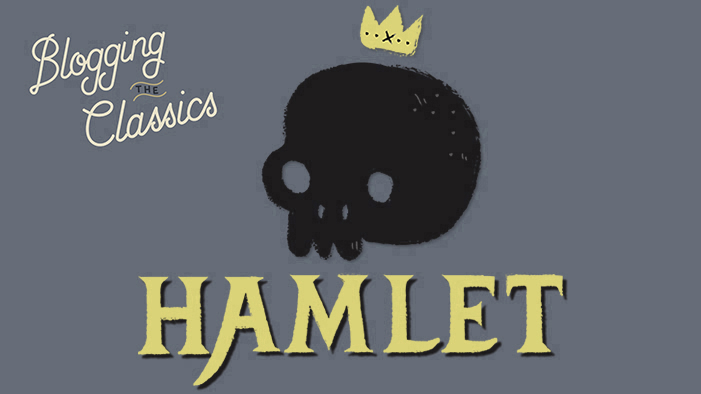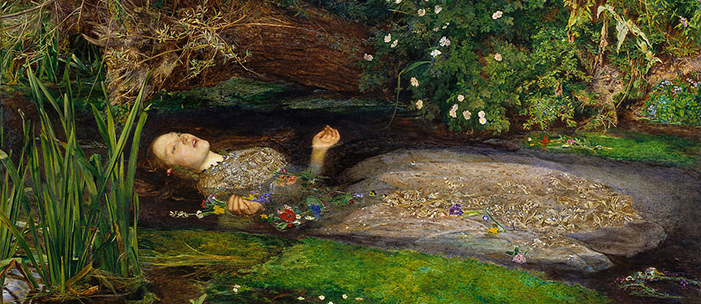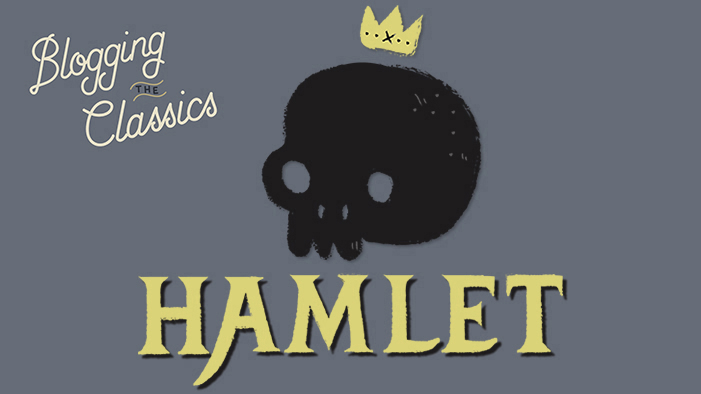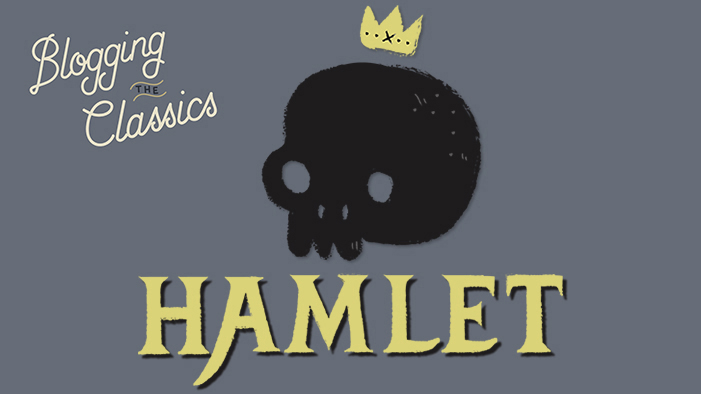Blogging Hamlet: Part 11

I used to think the most hilarious fictional funeral I would ever get to read would be Tom Sawyer’s. You know, the one where he wasn’t actually dead and it was all just a wacky misunderstanding. But then I read this section of Hamlet, and let me tell you, it is a TREAT.
Last time, Claudius and Laertes joined forces to try and kill Hamlet. They currently have three different assassination plots in the works, which seems excessive. You know the proverb “throw enough mud at the wall and some of it will stick”? It’s like they’re doing that, but with murder.
Also, Ophelia died. Here is that moment captured in art, probably with the caption “Well it sure would be a shame if I drowned right now, I mean that would just be the worst.”

Wikimedia Commons
This brings us to Act 5, Scene 1. Two gravediggers are hard at work digging Ophelia’s final resting place. She’s been dead for about twelve hours, which I guess is just enough time for people to begin slandering her good name. See, everyone’s pretty sure she committed suicide. However, the coroner says it was an accident. Since this is the late 1500s and CSI: Elsinore doesn’t yet exist, we just have to take his word for it. I bet his job mainly consists of glancing at the body, going “Yep, this was an accident if I ever saw one,” and accepting bribes from the family of the deceased, which is a career option I never considered but one at which I think I’d excel.
You’ll remember from earlier in the play (see: “TO BE OR NOT TO BE”) that suicide in these times is a big fat NOPE. It goes against all kinds of Christian doctrine. Indeed, the two gravediggers feel certain that the only reason Ophelia’s getting a proper Christian burial is because her family has money. To be fair, we can’t say FOR SURE whether she killed herself or not. I have no clue why we don’t ask Gertrude, who was apparently there when it happened, but it’s probably better that we don’t. This way, the two gravediggers get to have an entire conversation about action vs. passivity, one that speaks to the larger narrative themes.
And speaking of which, here comes Hamlet, our favorite vengeful do-nothing. He’s with Horatio. (Of course he is.) They don’t know that this grave is for Ophelia—they don’t even know that Ophelia has died. They just happen to be there, because I guess Hamlet likes to take strolls through graveyards for fun sometimes.
They watch from a distance. The gravediggers make puns about religion and death, because this is a Shakespeare play and what else are they supposed to do, and then one of them asks his fellow to go grab him some liquor. The first gravedigger continues his work, singing as he does it. As the only person in the world who has ever thought about death or known someone who has died, Hamlet finds this INSULTING. The guy could AT LEAST have the decency to soliloquize needlessly about the unrelenting inevitability of the void!
The gravedigger tosses a skull over his shoulder. Hamlet says the dead man could have once been an important politician or a courtier, and now he’s just a skull getting bounced around willy-nilly.
Hamlet approaches the gravedigger and asks him, “Whose grave is this?” What follows is a comedy of errors of “Who’s on first?” proportions:
HAMLET: Whose grave is this?
GRAVEDIGGER: Mine.
HAMLET: I guess it must be, since you’re the one currently lying in it.
GRAVEDIGGER: And you’re lying outside of it, so it’s not yours. But I swear to you, I may be lying in this grave, but I’m not lying TO YOU in this grave—it really is mine.
HAMLET: But you ARE lying to me, because graves are for the dead, not the living, so it can’t be yours. What man are you digging it for?
GRAVEDIGGER: Not a man, sir.
HAMLET: So a woman.
GRAVEDIGGER: Nope, not a woman either.
HAMLET: Who’s going to be buried in it, then?
GRAVEDIGGER: Someone that USED TO BE a woman, but she’s not a woman anymore, because she’s dead.
HAMLET: Oh my god.
ME: *throws this book across the room where it spontaneously bursts into flames, freeing me*
Hamlet asks how long he’s been a gravedigger. Coincidentally, the guy says he started digging graves and cracking wise on the very same day Hamlet Prime defeated Fortinbras. This was also the day Hamlet the Younger was born. However, the gravedigger says Hamlet the Younger has been sent off to England because he’s currently fifty shades of crazy, thereby confirming that Hamlet is Denmark’s most eligible but least recognizable bachelor.
NEXT UP, Hamlet demands to know whose skull the gravedigger is just flinging around all casual-like. The gravedigger says it once belonged to Yorick, the king’s jester from Hamlet’s childhood. Hamlet takes the opportunity to give us one of his most famous lines while also doing a bit of spontaneous skull touching:
Alas, poor Yorick! I knew him, Horatio, a fellow of infinite jest, of most excellent fancy.
He follows it up by having a long conversation with Horatio about how death comes for us all.
The funeral procession arrives, including Claudius, Gertrude, Laertes, a priest, and Ophelia’s coffin. Hamlet and Horatio hide. Laertes is demanding that the priest perform more funeral rites for her, but the priest says there are no more rites to perform. This is not unlike working in customer service, where a typical day involves someone saying, “Excuse me, where’s the gluten-free aisle?” and you saying, “Sir, this is a sporting goods store,” to which they say, “I’d like to speak to your manager,” and you say “Of course,” but your face is a long, silent scream.
Somewhere in there, Hamlet clues in to the fact that they’re burying Ophelia and that she may or may not have committed suicide. Man, I can’t believe he killed her father and somehow it ended poorly!
Laertes then decides to JUMP INTO THE GRAVE, COMPLETELY UNPROMPTED, FOR NO REASON OTHER THAN THE DRAMA OF IT ALL. I mean, at first he says, “Hold off [burying her]/Till I have caught her once more in mine arms,” but then he gets in and he’s like “BURY US BOTH IMMEDIATELY. THIS IS A RATIONAL THING TO DO.”
Hamlet, who can’t bear to see anyone being crazier and more melodramatic than he typically is, reveals himself with a flourish and a “THIS IS I, HAMLET THE DANE.” He then leaps into the grave WITH LAERTES, and the two have a good old-fashioned coffin-side brawl right there in the hole. It’s WILD and it comes completely out of nowhere and it almost—ALMOST—makes up for that whole thing with the gravedigger, but not quite.
Hamlet and Laertes get pulled apart, and Hamlet is like, “EXCUSE ME, YOU CAN’T HAVE LOVED OPHELIA, BECAUSE I AM THE ONLY PERSON WHO’S ALLOWED TO HAVE LOVED OPHELIA.” Someone should probably say, “Hamlet, remember when you called her a whore and then said you didn’t love her?” but alas, nobody does. Someone should probably also say, “Why are we just accepting that Laertes’ love for Ophelia is on par with Hamlet’s love for Ophelia? OH WAIT I KNOW IT’S BECAUSE LAERTES IS IN LOVE WITH HIS SISTER, WE CALLED IT ALL THE WAY BACK IN ACT 1, SCENE 3,” but nobody says that either.
Hamlet screams at everybody a bit more, and then he storms off with Horatio in tow. The scene is set for a final showdown. I can’t wait to see how everyone dies the story ends!
THOUGHTS:
- Ophelia’s possible suicide is something that once again highlights Hamlet’s internal struggle. On the one hand, she might have taken her own life, which is an action and the sort of thing Hamlet’s been unable to do successfully. On the other, she may have just drowned, which is more passive and parallels Hamlet letting things happen rather than making them happen himself.
- Hamlet says he can’t believe Laertes would “outface [him by] leaping in her grave.” Conclusion: Hamlet lives for drama, check and mate.
Catch up on parts 1 through 10 of Blogging Hamlet here, or go check out the SparkNote!















